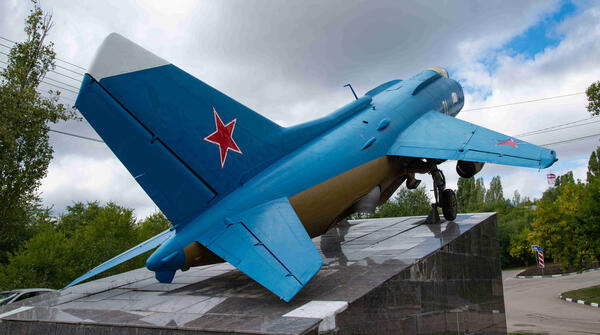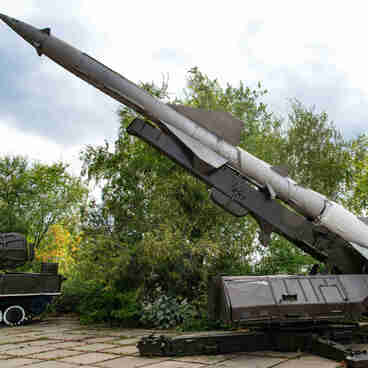The Yak-38 carrier-based attack aircraft was developed in the design bureau of the Moscow Machine-Building Plant “Skorost” (“Speed”). The project was led by Stanislav Grigoryevich Mordovin. The aircraft entered service in 1977.
The Yak-38 was an all-metal, cantilever, mid-wing aircraft with low-aspect-ratio wing. It had a swept wing design, retractable landing gear and a sealed cabin. To fit the aircraft in the hangar bays of aircraft carriers, the wing ends were designed in such a way that they folded up using hydraulic cylinders.
It was decided to use aluminum alloys as the main structural materials of the airframe. The aircraft was equipped with combined power plants: one lift-thrust engine and two lift engines.
The on-board equipment made it possible to use the Yak-38 in almost any weather conditions and at any time of day, taking off from land or ships.
The Yak-38 was capable of hitting targets above water or land, as well as leading effective air combat operations. The aircraft did not have built-in weapons; thus, four underwing pylons were designed for external stores.
The aircraft carried a number of weapons in its underwing pylons. Those included R-60 guided air-to-air missiles, Kh-23 and Kh-25 air-to-ground guided missiles, pods with unguided missiles of various calibers. In addition, the Yak could be armed with free-fall bombs of up to 250-kg caliber, single-use cluster bombs and tanks with incendiary mixtures. The total mass of the combat load was 2000 kg.
The Yak-38M model was developed in 1985. It was distinguished by more powerful engines, drop fuel tanks and a modernized chassis design. The fuel consumption of the new engines increased, however, the improved thrust and flight range allowed them to confidently take off in any latitudes.
The world’s first automatic ejection system for emergency situations was installed on this carrier-based attack aircraft. In particular, it was activated in case of engine failure or jet control malfunctions at low speeds and in hover mode. The Yak-38 was manufactured at the Saratov Aviation Plant until 1988. In total, there were 231 units of this aircraft.
The Yak-38 was an all-metal, cantilever, mid-wing aircraft with low-aspect-ratio wing. It had a swept wing design, retractable landing gear and a sealed cabin. To fit the aircraft in the hangar bays of aircraft carriers, the wing ends were designed in such a way that they folded up using hydraulic cylinders.
It was decided to use aluminum alloys as the main structural materials of the airframe. The aircraft was equipped with combined power plants: one lift-thrust engine and two lift engines.
The on-board equipment made it possible to use the Yak-38 in almost any weather conditions and at any time of day, taking off from land or ships.
The Yak-38 was capable of hitting targets above water or land, as well as leading effective air combat operations. The aircraft did not have built-in weapons; thus, four underwing pylons were designed for external stores.
The aircraft carried a number of weapons in its underwing pylons. Those included R-60 guided air-to-air missiles, Kh-23 and Kh-25 air-to-ground guided missiles, pods with unguided missiles of various calibers. In addition, the Yak could be armed with free-fall bombs of up to 250-kg caliber, single-use cluster bombs and tanks with incendiary mixtures. The total mass of the combat load was 2000 kg.
The Yak-38M model was developed in 1985. It was distinguished by more powerful engines, drop fuel tanks and a modernized chassis design. The fuel consumption of the new engines increased, however, the improved thrust and flight range allowed them to confidently take off in any latitudes.
The world’s first automatic ejection system for emergency situations was installed on this carrier-based attack aircraft. In particular, it was activated in case of engine failure or jet control malfunctions at low speeds and in hover mode. The Yak-38 was manufactured at the Saratov Aviation Plant until 1988. In total, there were 231 units of this aircraft.





